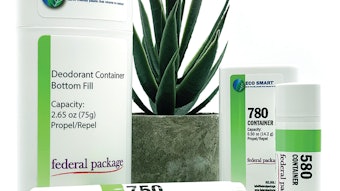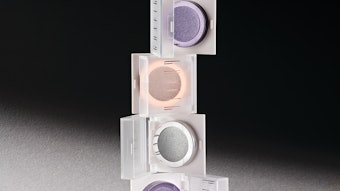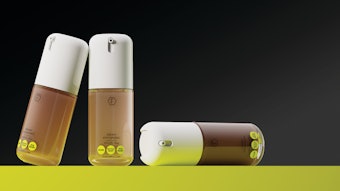- Going green and increasing sustainability require a strategic plan.
- Perceived excess product packaging that consumers throw away is the number-one anti-environment packaging habit to avoid.
- Engaging consumers in a sustainability effort—offering rewards for returning used packaging, for example—both builds the brand/consumer relationship and aids in meeting corporate green goals.
Eco-conscious consumers want to purchase high-integrity products in packaging that reflects their desire to help the environment. They also demonstrate greater loyalty to environmentally and socially responsible brands, even in challenging economic times. “Answering their call for green products is good for business—and the planet,” said Dean Maune, executive director package development, Aveda.
Bath and body brands that want to be more green have to put a strategic plan together. People are much more critical of environmental claims now than they were in the past. “Do your homework,” said JoAnn Hines, packaging consultant. “What do you want out of your package? As you begin to understand your product and who is buying it, you will discover there is not any one answer for every company.”
But with consumer awareness continuing to rise, marketers are driven to seek greener ways to accomplish their mission. Until the day comes that all products are packaged in equally affordable, durable, biodegradable packaging, marketers are taking steps they can in the right direction. They are making choices to reduce, reuse, recycle and re-purpose packaging to reinforce an eco-conscious philosophy without sacrificing functionality or quality.
Reduce
Perceived excess product packaging that consumers throw away is the number-one anti-environment packaging habit to avoid, according to Hines. In response, more companies are reducing packaging. Doing so also helps to avoid unnecessary expenses, not a small matter in today’s economy. Origins’ folding cartons, for example, are not only made from 80% PCR paper, but they are produced with wind power. The 20% that is virgin paper comes from forests that are Forest Stewardship Council members. Making even one of those changes makes an eco-friendly impact that can translate to gains with consumers.
“When developing a new package, key considerations are reducing the size, weight and energy used to produce our packaging, while fulfilling the design concept,” said Maune. Aveda has a Material Use Manual that defines the company’s mission and policy on material use as well as strategic priorities. The manual outlines preferred materials and prohibited materials, such as PVC. “Materials are chosen that have minimal environmental impact and the highest possible level of PCR content,” he explained. Lush has taken this philosophy to the extreme, offering 55% of its products with no packaging at all. The company has designed unpackaged, unpreserved deodorant, bath bombs, bubble bars, massage bars, body butters, sugar scrubs and many other innovative “naked” products. The brand’s 55g shampoo bar is the equivalent to three shampoo bottles, so it lasts longer, too. The most recent introduction is a range of new sugar scrubs that, unlike scrubs that come heavily packaged in a kilner glass jar, are molded in the factory and displayed with no packaging in the shop. The brand also has just launched 13 Soap–Unlucky for Dirt, an unpackaged soap designed by managers in the U.K. In conjunction with the Naked Campaign last year, Lush also switched all plastic bottles for liquids and creams to 100% postconsumer waste bottles. “Customers are more aware of items that are over-packaged, and hopefully will put pressure on more companies to make their packaging greener,” said Ruth Andrade, environmental officer, Lush.
Designing to eliminate excess packaging or making packaging lighter and easier to recycle should be at the forefront of packaging design, according to Andrade. She would like to see more compostable materials and plant-based polymers used. “Hopefully, we will be able to use more returnable containers, encouraging customers to bring their own packaging as well,” she explained.
Reuse
For many brands available on mass retail shelves, going “naked” isn’t an option. Refillable packaging is one alternative. But the idea has hurdles to overcome, as it has, in large part, gone the way of the milkman. In a movement that progresses “back” to those good old days, reusable and refillable primary packages are hitting the shelves in greater numbers, even after some failed attempts. Loyal do-gooders aren’t giving up.
Garden Girl’s Kristin Miller, founder/owner, is always on the lookout to improve but considers herself on the cutting-edge in terms of eco-friendly packaging. The brand uses recyclable packaging, biodegradable labels and wraps in compostable cellophane bags. When products are shipped, all packing materials received from supply shipments are reused. “We do this because we believe that it is vital for everyone to do their part to reduce their impact on this earth,” said Miller. “It’s the right thing to do. And the best part is you save money.”
Garden Girl is a small, personal natural brand available online, and is able to build a bond with customers when both take an active part in the reuse of containers. Miller encourages recycling, and established a “refill” program for some of the top-selling treatment products. “This not only saves the customer money, but it reduces waste,” she explained. Customers purchase the standard jar the first time, then subsequent purchases can be of refills at a reduced price with minimal packaging. They come in small bags that can be emptied back into the original jar—once it has been sterilized. “Our focus on packaging starts with making sure it is appealing, functional and protective,” said Miller. “But because we are committed to reducing waste and our impact on this earth as a whole, we layer on the requirement that our packaging is as eco-friendly as possible.” The brand also uses recyclable PET plastic and glass.
Innovations and improvements are being made to deliver environmentally friendly refill packaging for liquid soaps as well. Created by Alcan Packaging, the Softsoap Hand Soap Refill Pouch, for example, benefits from an energy efficient manufacturing process, lightweight materials and collapsibility to offer environmental benefits in the areas of reduced emissions, waste and energy consumption.
Recycle
Certainly, from a packaging industry standpoint, the effort has long been made to encourage recycling. Origins is not the only brand that primarily uses PET and polypropylene for its packaging simply because it can be recycled. “Our focus continues to be cost-effective environmentally friendly packaging,” explained Alan Bodker, executive director of package development.
In April, Origins launched The Return to Origins Recycling Program in the U.S. to accept all cosmetic empties, regardless of brand, at more than 450 Origins retail stores and department store counters. The program was in response to the growing percentage of beauty packaging being thrown away each year. “We hope to inspire the rest of our industry to take proactive measures to implement practices that protect our communities and the environment,” said Bodker. The brand offers further enticement, too. Each time consumers bring in empties, they receive a free sample of the Origins product of their choice. Since the program inception, Origins’ free-standing retail stores on the East and West coasts have received approximately 700 pounds and 900 pounds of returns, respectively. All of the collected packaging will either be recycled, when possible, or responsibly converted to energy.
Following Origins’ lead, Sweetsation Therapy began the “Recycle and be Rewarded” program earlier in 2009 to encourage its customers to get involved in the recycling process. When the brand’s used jars and bottles, all 100% recyclable, are returned for re-melting, customers receive a gift of one product of their choice, a $20 value. The idea behind it is to make consumers more alert to the problem and get motivated to do something about it. “Many materials can be recycled but aren’t because of the time commitment involved,” said Natalja Millsap, owner, Sweetsation Therapy. “Our program should be enticing enough to transform one customer at a time.” The company posted information about the program on its Web site (www.sweetsationtherapy.com) and includes a flyer with every purchase. It’s a work in progress, and Millsap is looking to add new marketing to promote it. “We have had very positive feedback through e-mails and comments, and we expect a good response once those who made purchases at the beginning of the promotion use up their product,” said Millsap.
Postconsumer recyclate (PCR) from polyethyelene terephthalate (PET) has become so common, it’s rare to find a brand that does not use some percentage of recycled materials in its packaging, although quality has been an issue. Alcan Packaging Beauty has entered the market with a plastic tube made from up to 60% recycled materials that the company claims has the same visual and technical qualities as its other tubes. The environmentally friendly PCR tube is a multilayer structure that the company claims guarantees product/packaging compatibility, as the inner layer is still made from virgin material.
For companies looking to use 100% PCR bottles, clean certified recycled resins are becoming more available and at improved quality levels. Suppliers were at first hesitant to work with 100% postconsumer recycled plastic materials for fear that the finished product would be brittle. “We’ve worked through that, and now have at least four manufacturers worldwide who are able to produce various 100% PCR plastic packaging for Lush,” said Lisa Apfelbaum, creative buyer, Lush.
Although Alpha Packaging is one such manufacturer that can make bottles with 100% postconsumer recyclate using regrind, the company recommends that marketers conduct their own compatibility tests before packaging products. Alpha utilized PCR collected in community recycling programs, cleaned, pelletized and approved by the FDA for food contact for manufacturing. The company also has run some tests with postconsumer high-density polyethylene, but at the present time does not have an FDA-approved source for postconsumer HDPE.
While the cost is slightly higher than for bottles made from virgin PET due to extensive sorting, cleaning and processing, the cost can be expected to remain stable, if not decline, as consumers continue to increase the recycling of PET packaging. According to the PET recycling industry, only about 26% of all PET bottles were recycled in the U.S. in 2008.
Repurpose
When all else fails, there is the reuse of old product packaging and turning it into something else entirely. TerraCycle has turned this idea into a very profitable business. Co-founders Tom Szaky and Jon Beyer take packages and materials that are challenging to recycle and transform them into affordable, high-quality goods—including tote bags, kites and umbrellas. The up-cycling process requires far less energy than recycling, and yields much higher amounts of usable material, according to the company.
Consumers get involved by signing up for free. They are then paid to collect plastic bags, wrappers and packages and send them to TerraCycle using the company’s shipping bags. In addition to partnering with Frito-Lay and Mars, TerraCycle is working on programs to upcycle packaging from select Kimberly Clark brands and re-purpose material from Aveeno.
Another way to re-purpose packaging is to plant it. Brands such as Pangea Organic and Pure & Natural use molded pulp and recycled paper with embedded seed to create new life with the planted boxes. Pangea Organics collaborated with UFP Technologies to create the 100% compostable, biodegradable and plantable product packaging for the brand’s bar soaps. It is manufactured with zero waste and created from 100% postconsumer newsprint—without glues and dyes. Seeds for medicinal herbs found within the products will grow, following packaging directions.
Continued Innovation
Suppliers are hard at work toward solutions and innovative ways to improve their packaging and processes. And as companies get involved to meet the growing demands, competitive forces will reduce the sometimes prohibitive costs.
“Manufacturers and suppliers have become more aware of environmental changes, and are taking steps to work with their customers to improve impact down the supply chain,” says Lush’s Apfelbaum. “New initiatives have been well-received, and have resulted in virgin plastic, crude oil, fresh water and virgin paper savings.”
Continued innovation that improves the quality of biodegradable or recyclable materials will not go unnoticed. Marketers such as Aveda are excited about suppliers who are developing new materials that can be easily recycled from bio-plastics, for example.
Aveda strives to lead by example, educating business partners on environmental packaging and manufacturing, and inspiring local action to reduce, reuse and recycle for global benefit. “A major challenge is the lack of worldwide environmental solutions, and the absence of global standards or laws for recycling and reuse,” said Aveda’s Maune. “REACH legislation in Europe has brought some harmonization among European states in terms of waste reduction, reuse and recycling, though wider-reaching global standards are still far-off.”
Aveda has the good fortune to work with suppliers who are willing to take on whatever challenge is asked of them, and Aveda credits collaboration with a supplier for the design of its green cartons. The brand’s secondary retail packaging contains an average of 70% PCR content, a 20% improvement made in a one-year period, according to Muane. The company continually confers with supplier partners on how best to “design for the environment.” Aesthetically, there is an opportunity to highlight the individual characteristics of the available materials when designing packaging. “We see it as an incentive for creativity—an opportunity every day to think outside the box,” concluded Maune.
Sara Mason is a freelance writer based in the Chicagoland area. She was previously managing editor of GCI magazine.



![Curious about the latest trends in Beauty and Personal Care innovation? [download free report]](https://native-x.imgix.net/allured/65fde687b40d3e0001e2ce0d/_Thumbnail%20Image%201-19-24.jpg?crop=focalpoint&fit=crop&fp-x=0.5&fp-y=0.5&h=191&w=340&auto=format%2Ccompress&q=70)






